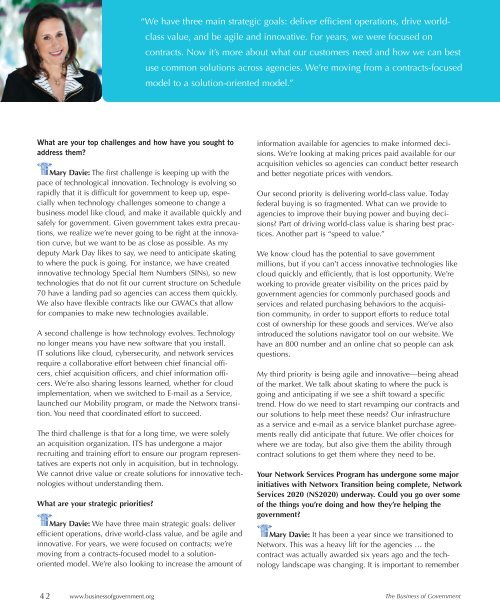1hmPUyl
1hmPUyl
1hmPUyl
Create successful ePaper yourself
Turn your PDF publications into a flip-book with our unique Google optimized e-Paper software.
“We have three main strategic goals: deliver efficient operations, drive worldclass<br />
value, and be agile and innovative. For years, we were focused on<br />
contracts. Now it’s more about what our customers need and how we can best<br />
use common solutions across agencies. We’re moving from a contracts-focused<br />
model to a solution-oriented model.”<br />
What are your top challenges and how have you sought to<br />
address them?<br />
Mary Davie: The first challenge is keeping up with the<br />
pace of technological innovation. Technology is evolving so<br />
rapidly that it is difficult for government to keep up, especially<br />
when technology challenges someone to change a<br />
business model like cloud, and make it available quickly and<br />
safely for government. Given government takes extra precautions,<br />
we realize we’re never going to be right at the innovation<br />
curve, but we want to be as close as possible. As my<br />
deputy Mark Day likes to say, we need to anticipate skating<br />
to where the puck is going. For instance, we have created<br />
innovative technology Special Item Numbers (SINs), so new<br />
technologies that do not fit our current structure on Schedule<br />
70 have a landing pad so agencies can access them quickly.<br />
We also have flexible contracts like our GWACs that allow<br />
for companies to make new technologies available.<br />
A second challenge is how technology evolves. Technology<br />
no longer means you have new software that you install.<br />
IT solutions like cloud, cybersecurity, and network services<br />
require a collaborative effort between chief financial officers,<br />
chief acquisition officers, and chief information officers.<br />
We’re also sharing lessons learned, whether for cloud<br />
implementation, when we switched to E-mail as a Service,<br />
launched our Mobility program, or made the Networx transition.<br />
You need that coordinated effort to succeed.<br />
The third challenge is that for a long time, we were solely<br />
an acquisition organization. ITS has undergone a major<br />
recruiting and training effort to ensure our program representatives<br />
are experts not only in acquisition, but in technology.<br />
We cannot drive value or create solutions for innovative technologies<br />
without understanding them.<br />
What are your strategic priorities?<br />
Mary Davie: We have three main strategic goals: deliver<br />
efficient operations, drive world-class value, and be agile and<br />
innovative. For years, we were focused on contracts; we’re<br />
moving from a contracts-focused model to a solutionoriented<br />
model. We’re also looking to increase the amount of<br />
information available for agencies to make informed decisions.<br />
We’re looking at making prices paid available for our<br />
acquisition vehicles so agencies can conduct better research<br />
and better negotiate prices with vendors.<br />
Our second priority is delivering world-class value. Today<br />
federal buying is so fragmented. What can we provide to<br />
agencies to improve their buying power and buying decisions?<br />
Part of driving world-class value is sharing best practices.<br />
Another part is “speed to value.”<br />
We know cloud has the potential to save government<br />
millions, but if you can’t access innovative technologies like<br />
cloud quickly and efficiently, that is lost opportunity. We’re<br />
working to provide greater visibility on the prices paid by<br />
government agencies for commonly purchased goods and<br />
services and related purchasing behaviors to the acquisition<br />
community, in order to support efforts to reduce total<br />
cost of ownership for these goods and services. We’ve also<br />
introduced the solutions navigator tool on our website. We<br />
have an 800 number and an online chat so people can ask<br />
questions.<br />
My third priority is being agile and innovative—being ahead<br />
of the market. We talk about skating to where the puck is<br />
going and anticipating if we see a shift toward a specific<br />
trend. How do we need to start revamping our contracts and<br />
our solutions to help meet these needs? Our infrastructure<br />
as a service and e-mail as a service blanket purchase agreements<br />
really did anticipate that future. We offer choices for<br />
where we are today, but also give them the ability through<br />
contract solutions to get them where they need to be.<br />
Your Network Services Program has undergone some major<br />
initiatives with Networx Transition being complete, Network<br />
Services 2020 (NS2020) underway. Could you go over some<br />
of the things you’re doing and how they’re helping the<br />
government?<br />
Mary Davie: It has been a year since we transitioned to<br />
Networx. This was a heavy lift for the agencies … the<br />
contract was actually awarded six years ago and the technology<br />
landscape was changing. It is important to remember<br />
42<br />
www.businessofgovernment.org<br />
The Business of Government


